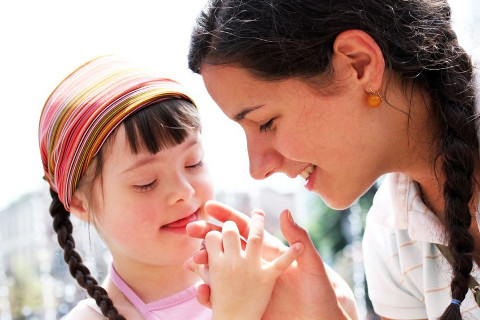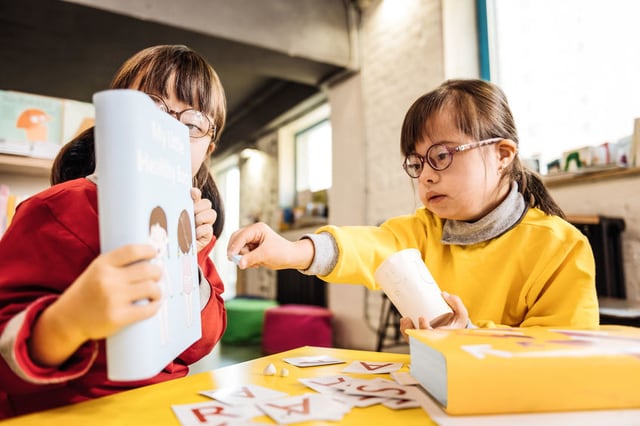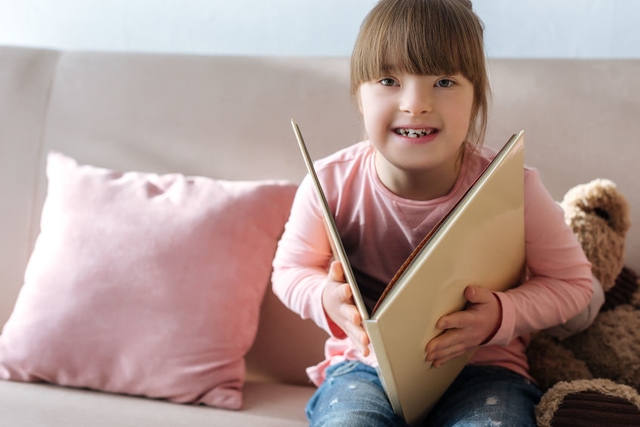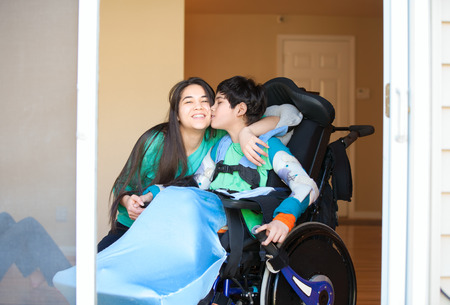Reading and being read to from a young age are considered to be vital for improving language as well as memory skills. This is true for all children, including individuals with Down syndrome. A child with Down syndrome will go on to learn how to read just like any other developing child.
These children generally have no trouble relying on their visual memory skills. However, expressing their thoughts are often challenging for them.

A team of researchers published an article in Down Syndrome Research and Practice in 1993 that investigated the reading skills of children with Down syndrome. The father of a child with Down syndrome wrote to the team explaining how he had discovered a new skill his daughter had learnt.
He had taught his daughter (Sarah) to read words from flashcards. The father focused on the words he wanted her to use in speech. After some time, he realised that she began using the printed words from the flashcards much faster than words that she had only learnt in spoken form.
This letter reached the researchers when Sarah was twelve years old. They were also surprised to learn that she attended mainstream schools for most of her education. In 1993, it was exceptional for a child with Down Syndrome to be able to read and attend school. For this reason, they felt that it was vital to look further into the matter.
The story suggested that reading could be a possible way for children with Down syndrome to develop their language skills.
We now know that many children, like Sarah, with Down syndrome, can start developing their reading skills from an early age. It has been found that most of these children have started to read single words by ages 3 or 4, or earlier.
Whichever way you look at it, it is reasonable to say that these children understand language much better than being able to express it.

The experts agree that children with Down syndrome can benefit greatly from being read to. They also argue that it is a great idea to encourage these children to be introduced to reading lessons from an early age. The key here would be to strengthen the skills they already have at hand like their visual memory skills.
Additionally, reading can boost speech and language skills in children. Reading could also improve articulation. Through reading, children with Down syndrome can learn to speak clearly and correctly.
➡️ Related Read: Understanding Speech Language Characteristics of Children With Down Syndrome
In the same way, we can teach these children to spell words correctly. We can forge associations between words, letters and sounds.
These young children learn to read by connecting whole words with their meanings. They need to learn the whole word first before they learn to separate the individual sounds to apply their knowledge of how each letter sounds to the task of reading.
Nonetheless, they are eventually capable of learning the names of all the letters as well as the sounds associated with these letters.
Where to Start?
Young children with Down syndrome should be encouraged to enjoy educational games. They should learn about letters, words and sounds with their peers.
Children who read and who love being read to learn that books are fun! They also have the opportunity to recognise that the words on the pages carry meaning and that they tell the actual story.

Reading to your child with Down syndrome is perhaps one of the most fruitful ways in which you can help your child to be ready to read and write.
You can be the one who inspires them to be interested in reading books and you could help to develop their grammar skills and expand their vocabulary. With that said, you have the chance to introduce your child to reading in a fun way.
Popular Approaches
First off, you can teach him/her to read whole words. You can try to teach whole words with picture matching, picture selecting, picture naming and sight words.
1. Picture Matching
You can use pictures in matching pairs to create an enjoyable activity. Choose one of the pictures and request that your child points out the matching picture.
For example, use a picture of a flower and say: “This is a flower, which of these other pictures is the same?”
Children with Down syndrome typically fare better with error-free learning. If your child struggles to find the correct picture, guide their hand towards the correct one.
2. Picture Selecting
Then you could ask your child to hand you certain pictures. For instance, ask for a spoon and allow them to pick the picture of the spoon out to give to you. Again, you are allowed to guide their efforts.
3. Picture Naming
To help your child name the pictures, you could, for instance, hold up a picture of a ball and say: “What is this? It is a ball. Can you say ball?”
You could also repeat the words after they’ve been said to model the correct pronunciation.
4. Sight Words
When your child is comfortable with matching, selecting and naming pictures, you can go back to the start and teach them the same words. However, this time, you need to teach them the written words.

Then you can move on to reading short sentences and eventually longer sentences. Learning the sounds and images associated with individual words will come later.
Determine set goals for your child and watch them learn. Try to base the activities and the reading lessons on whatever your child is interested in.
No rule says learning can’t be fun!
This article is contributed by Dr Lisa Lim Su Li, Speech Language Pathologist at The Speech Practice. Her professional experience over 10 years includes work in acute and rehabilitation hospitals and special schools, both in Australia and Singapore.
References:
Hughes, J. (2006) Teaching reading skills to children with Down syndrome. Down Syndrome News and Update, 6(2), 62-65. doi:10.3104/practice.349
Buckley, S, and Bird, G. (1993) Teaching children with Down syndrome to read. Down Syndrome Research and Practice, 1(1), 34-39. doi:10.3104/perspectives.9
Cunningham, C. C., Glenn, S. M., Wilkinson, P., & Sloper, P. (1985). Mental ability, symbolic play and receptive and expressive language of young children with Down’s syndrome. Child Psychology & Psychiatry & Allied Disciplines.
* * * * *
Stay in touch! Subscribe to our Telegram here for all our latest updates.
Like what you see here? Get parenting tips and stories straight to your inbox! Join our mailing list here.


























































